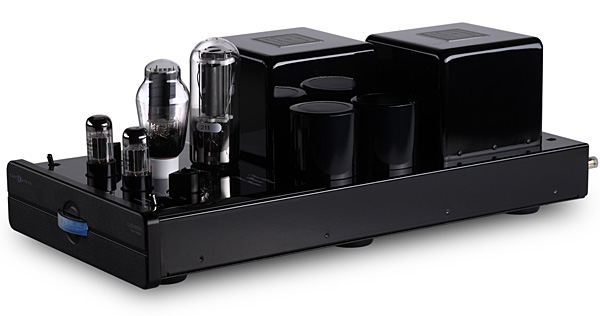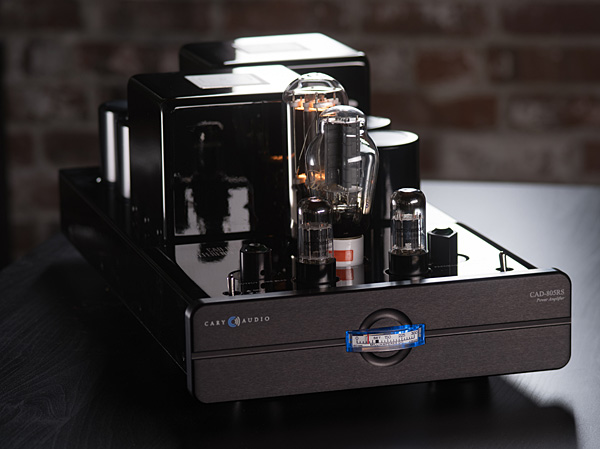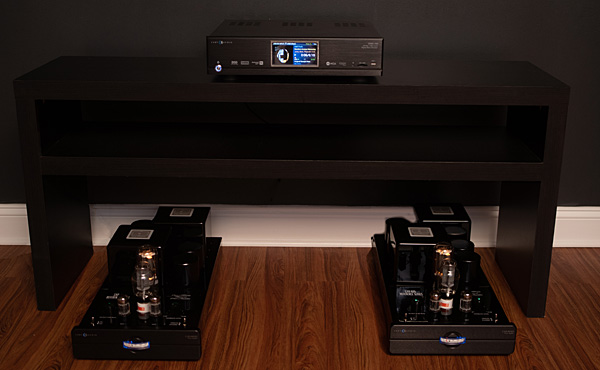| Columns Retired Columns & Blogs |
Love theme from the movie 'Romeo and Juliet' ............ Nino Rota :-) .........
Arthur Fiedler & Boston Pops Orchestra :-) .............
Henry Mancini :-) ............
Andre Rieu :-) .............
In any event, for most of the Carys' time in my system, I left their power cords plugged straight into my household AC, without power conditioning of any sort, and connected my DeVore Fidelity Orangutan O/93 speakers, which have a specified nominal impedance of 10 ohms, into the amps' 8 ohm outputs. With exceptions noted below, the CAD-805RSes were perfectly well behaved: They turned on and off without making thumps through the speakers, and my adjustments of the feedback and bias settings were equally silent.

Listening with 211 output tubes
Before the end of my first day with the Cary CAD-805RSes—with the 211 output tubes in place, the speakers connected to the 8 ohm outputs, and the feedback turned off—I'd noted four characteristics that were consistent with every recording I played: The amps allowed music to sound physically bigger—in particular, wider—than did my Shindo amp; with stereo records, centrally positioned voices and solo instruments popped forward from the mix in a manner described in my notes as "pure, not-unexpected single-ended magic"; tones below, say, 100Hz were elevated in level relative to everything else; and the very highest tones, though not harsh, seemed strangely disconnected from the tones lower in frequency, in a manner I associate with the effects of a supertweeter whose crossover network has not been correctly dialed in (ask how I know). That disconnectedness went away in a couple of days, leaving the Carys' top end pleasantly extended and otherwise unremarkable; as for the excessive bass, I'll come back to that in a moment or two.
I can point to any number of stereo recordings whose spatial details were brought to palpable life by the Cary amps. That rightly praised chestnut, Fritz Reiner and the Chicago Symphony Orchestra's recording of Rimsky-Korsakov's Scheherazade (LP, RCA Living Stereo LSC-2446), comes to mind, as does the even-better-engineered recording of Mendelssohn's music for A Midsummer Night's Dream by Peter Maag and the London Symphony Orchestra (LP, Decca/Speakers Corner SXL 2060). But what sealed the deal for me was the way the CAD-805RSes made less-spectacular stereo recordings spatially compelling by separating featured performers from their audible surroundings—again, something I associate with good single-ended amplification. I recall no better example than the way Jerry Donahue's electric-guitar solos in Bob Dylan's "Too Much of Nothing," from Fotheringay's eponymous debut album (LP, Island ILPS 9125), eased their way to the front of the mix. This was also true of drummer Gerry Conway's ride cymbal on the same album's "The Pond and the Stream," and of many of Sandy Denny's lead vocals, even if those vocals sound a mite veiled on a couple of songs.
Fotheringay, the first record I played through the Carys after running them in for six hours or so, sounded colorful and engaging in every way. But it was the second record I played that won me over: the Mozart Requiem, with Roland Bader conducting the Stuttgart Philharmonic, the Böblingen Choir, and soloists (LP, Vox STPL 512.740). As I'd expected it might, through the Carys, this stereo recording sounded big, but here I had the distinct impression of the extreme left and right sides of the stage being farther forward than usual, as if the entire stage was curved—it was, for lack of better words, inviting and enveloping, even comforting. The timpani sounded sublime: Yes, they were probably too prominent, but they had tone and impact for days—I loved it!

Throughout the days that followed, the CAD-805RSes continued to distinguish themselves. Alfred Deller and the Deller Consort's recording of Purcell's "O Solitude" (LP, Harmonia Mundi HM 247) sounded breathtakingly good. Deller's distinctive countertenor was true of tone and texture, as was the bass continuo, and the sense of the singer's physical presence between my speakers was uncanny. This experience was also notable for the deep, almost chilling nothingness around the voice and the bass viola da gamba—to call it mere silence seems insufficient—that kept me riveted on the musical beauty and sonic color of the performance. Although the bass viol was more prominent through the Carys than through my Shindo, that wasn't bothersome, perhaps because the recording itself is far from bass-heavy.
I moved on to MoFi's recent and great-sounding remastering of the Bill Evans Trio's classic Sunday at the Village Vanguard (2 45rpm LPs, Riverside/Mobile Fidelity Sound Lab Ultradisc UD1S 2-002). Again I delighted in the Carys' large-scale sound—but here the tendency toward excess bass made Scott LaFaro's double bass sound too prominent, with less-than-optimal pitch definition on some notes in the loose intro to "All of Me." At this point in the review I began to experiment with the CAD-805RS's feedback control, noting that turning that knob above 0dB made the deepest notes sound better controlled, with quicker note decays, even as it made Paul Motian's drumming sound a bit less forceful than with no feedback at all. I eventually hit on a feedback setting of 6dB as a good compromise: now bass notes were tighter and not quite as overpowering, if still more prominent than usual—while Motian's drumming remained appropriately explosive, if not quite as dangerous as before.
Listening with 845 output tubes
After spending another couple of days using the Carys with their 211 output tubes and 6dB of negative feedback, I powered down the system and swapped in the 845 output tubes, at first with the feedback controls set for 0dB. I went back to the Bill Evans album and found that the 845s without feedback sounded almost as tight as the 211s with, and the deepest bass notes, though still too generous, were in better balance with the rest of the audioband. And when I bumped the feedback up to the same 6dB setting that had produced the best sound with the 211 tubes, the lowest octaves became even clearer and more detailed—Scott LaFaro's slides became a new delight—without apparent penalty. Evans's piano chords remained richly colorful, and although the application of feedback made the piano clearer in its note decays, its sound remained the antithesis of mechanical: those chords bled realistically into the silence of their surroundings, and Evans's senses of touch and sheer strength were evident throughout the album.
I dipped into a big set whose surfaces I've barely scratched—Maria Callas's Ses Récitals 1954–1969 (11 LPs, French EMI 26 165-54178-88)—to hear La Divina's performance, with Tullio Serafin and the Philharmonia Orchestra, of "Signor ascolta" and two other arias from Puccini's Turandot. Although the Carys weren't as dynamically nuanced as my Shindo stereo amp, they were just as good at honoring Callas's tone, and at conveying the drama behind the big ensemble pizzicati in the strings.

Mott the Hoople's brilliant and sadly underappreciated Brain Capers (LP, Atlantic SD-8304), the group's last before ditching longtime producer Guy Stevens in favor of David Bowie, remains one of my favorite Saturday-morning wake-up records; it also proved useful in determining whether the single-ended Carys could rock. In a word, yes. Used with the right speakers, good single-ended tube designs have always impressed me as being freer from timing distortions than many other amps, and with the companionably sensitive DeVore O/93s the Carys sounded very good indeed. Heavy though Peter "Overend" Watts's electric bass sounded, it wasn't sluggish, and the great, galloping drums of Dale "Buffin" Griffin—like Watts, now dead and gone—were a delight.
By the end of the Carys' time in my home, I realized that I clearly preferred the 845 tubes to the 211s.
Conclusions
Through that last day in my listening room, the sound of Cary Audio's CAD-805RS monoblocks was thoroughly engaging: I enjoyed every record I played through them, and though their deep-bass response was too generous, it was never unmusical—and was often decidedly fun.
No less important, evaluated solely on the basis of the quality of parts and the apparent amount of labor that have gone into it, the US-made CAD-805RS offers good value. I have a rough idea of what it costs to make just the transformers in this amp; although $15,995/pair isn't chicken chow, I find it difficult to imagine how two of these can be sold at retail for that price.
Twenty-five years after we first wrote about Cary Audio's flagship single-ended amp, the product and its genre endure. That the quirks of that genre also endure—the CAD-805RS was scarcely a bride of quietness—will mildly disappoint some, but will prove no obstacle to those adventuresome souls who crave from their playback systems, above all else, beauty. To them, the Carys speak a rare truth.

Love theme from the movie 'Romeo and Juliet' ............ Nino Rota :-) .........
Arthur Fiedler & Boston Pops Orchestra :-) .............
Henry Mancini :-) ............
Andre Rieu :-) .............

"I Was Made for Lovin' You" baby ......... Kiss :-) ............

These are old Dennis Had designs. They were great amps and a bit noisy. Surprised that small improvements weren't made in the years since Had left assuming the company intended to go back to their roots. The AES Six Pacs had to be the best value monoblocks to have ever been produced. I still have a pair in a closet somewhere with an SLP98 pre.

May be AD or JA could review the Carver Crimson/Raven 350 tube mono-bloc amps ($10,000) for comparison? ...... They are rated 350 WPC :-) ...........

This amp looks good without the protective net, but boring with the net on. The price (you can get a decent used car for this much money) and the measured THD are astronomical. In sum, a perfect toy for audiophiles swimming in money.